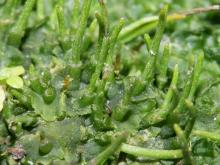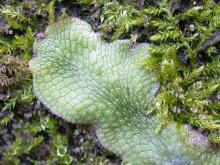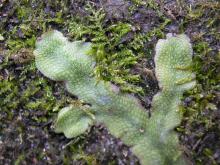Mosses, Liverworts, and Lichens
Media

Species Types
Scientific Name
4 species in Missouri
Description
With their flattened, green forms, hornworts resemble liverworts, but their spore-bearing structures are elongated and horn-shaped. As with liverworts and mosses, hornworts make forest floors, streamsides, and spring openings beautiful.
Media

Species Types
Scientific Name
About 112 species in Missouri
Description
Liverworts, along with mosses, make forest floors, streamsides, and spring openings beautiful. They’re fascinating but overlooked.
Media

Species Types
Scientific Name
Conocephalum salebrosum (formerly C. conicum)
Description
Snakeskin liverwort looks like large, flattened, irregular, overlapping straps. The surface is covered with polygon-shaped air pores, giving it a bubbly appearance similar to snakeskin. Look for it along streams, springs, and the moist bases of bluffs.
Media

Species Types
Scientific Name
Marchantia polymorpha
Description
Umbrella liverwort is the most famous liverwort in the world. It grows in green ribbons and is very common on the soil of potted plants. It typically forms cuplike gemmae on its upper surface. Its palm-tree-shaped archegona are distinctive, too.
Media

Species Types
Scientific Name
Riccia fluitans
Description
Floating crystalwort, or slender riccia, is a type of liverwort that floats in lakes, ponds, and streams, forming dense, tangled mats in shallow water. It’s also used as an aquarium plant.
Media

Species Types
Scientific Name
Porella spp.
Description
Porella liverworts are fairly common in Missouri, but few people recognize them when they see one. These scaleworts are some of our many species of leafy liverworts — small, mosslike plants that form traceries on rocks or trees.
Media

Species Types
Scientific Name
Flavoparmelia caperata
Description
The common greenshield lichen is a medium to large, green foliose lichen. Common and widespread in eastern North America, it grows on tree bark.
Media

Species Types
Scientific Name
Flavoparmelia baltimorensis
Description
The rock greenshield lichen is a medium to large, green foliose lichen. Common and widespread, it grows on rocks and is especially characteristic of dry, igneous woodlands.
Media

Species Types
Scientific Name
Parmotrema spp.
Description
Ruffle lichens are rather large, broad-lobed foliose lichens that are loosely attached to the substrate. The rounded edges of the lobes usually lift up and look ruffled. Hairlike cilia arise from the lobe edges. They usually grow on tree bark.
Media

Species Types
Scientific Name
Dermatocarpon spp.
Description
Stippleback lichens, or rock tripes, are almost always found on bluffs, boulders, and outcrops. They cling to their substrate by a single point of attachment and typically grow in clusters. The surface of these floppy-looking lichens is covered with tiny black dots.
See Also
About Mosses, Liverworts, and Lichens in Missouri
Mosses, liverworts, hornworts, and lichens seem rather similar, but these organisms are in very different groups. Mosses, liverworts, and hornworts are small, low plants usually found in damp habitats. Unlike more familiar plants, they lack veinlike structures and do not produce flowers or seeds — instead, they produce spores. Meanwhile, lichens are not plants at all: they are a collection of different fungi that have photosynthetic algae living within their tissues.





















